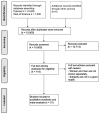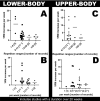Muscle strength gains per week are higher in the lower-body than the upper-body in resistance training experienced healthy young women-A systematic review with meta-analysis
- PMID: 37053143
- PMCID: PMC10101404
- DOI: 10.1371/journal.pone.0284216
Muscle strength gains per week are higher in the lower-body than the upper-body in resistance training experienced healthy young women-A systematic review with meta-analysis
Abstract
Background: Women are underrepresented in resistance exercise-related studies. To date only one meta-analysis provides concrete training recommendations for muscle strength gains through resistance training in eumenorrhoeic women.
Objective: This review aims to identify research gaps to advance future study in this area to expand the knowledge concerning resistance exercise-induced strength gains in women and to provide guidelines on the number of repetitions per set and the training frequency per week to enhance maximal muscle strength.
Methods: The electronic databases PubMed and Web of Science were searched using a comprehensive list of relevant terms. After checking for exclusion criteria, 31 studies could be included in the final analysis using data from 621 subjects. From these data sets, the ideal number of repetitions per set and also the training frequency per week were analyzed.
Results: In the lower body, the largest gains were achieved with 1 to 6 repetitions (17.4% 1RM increase). For lower-body exercises, the highest gains were achieved with 13 to 20 repetitions (8.7% 1RM increase). The lower body should be trained two times a week (8.5% 1RM increase). The upper body should be trained two (5.2% 1RM increase) to three times (4.5% 1RM increase) a week.
Conclusion: Women can increase their 1RM by 7.2% per week in the upper body and by 5.2% per week in the lower-body exercises. The upper body can be trained more than two times per week whereas the lower body should be trained two times. Women with intermediate experiences in RT and advanced performance level show more rapid increases in strength in the lower-body compared to the upper-body while no differences were found between upper and lower limb adaptations in RT-beginner subjects.
Copyright: © 2023 Jung et al. This is an open access article distributed under the terms of the Creative Commons Attribution License, which permits unrestricted use, distribution, and reproduction in any medium, provided the original author and source are credited.
Conflict of interest statement
The authors have declared that no competing interests exist.
Figures




Similar articles
-
The Minimum Effective Training Dose Required to Increase 1RM Strength in Resistance-Trained Men: A Systematic Review and Meta-Analysis.Sports Med. 2020 Apr;50(4):751-765. doi: 10.1007/s40279-019-01236-0. Sports Med. 2020. PMID: 31797219
-
Low-Load vs. High-Load Resistance Training to Failure on One Repetition Maximum Strength and Body Composition in Untrained Women.J Strength Cond Res. 2019 Jul;33(7):1737-1744. doi: 10.1519/JSC.0000000000003194. J Strength Cond Res. 2019. PMID: 31136545 Clinical Trial.
-
Effects of Low- vs. High-Load Resistance Training on Muscle Strength and Hypertrophy in Well-Trained Men.J Strength Cond Res. 2015 Oct;29(10):2954-63. doi: 10.1519/JSC.0000000000000958. J Strength Cond Res. 2015. PMID: 25853914
-
Effect of Lower-Body Resistance Training on Upper-Body Strength Adaptation in Trained Men.J Strength Cond Res. 2018 Jan;32(1):13-18. doi: 10.1519/JSC.0000000000001639. J Strength Cond Res. 2018. PMID: 29257792 Clinical Trial.
-
Are Trainees Lifting Heavy Enough? Self-Selected Loads in Resistance Exercise: A Scoping Review and Exploratory Meta-analysis.Sports Med. 2022 Dec;52(12):2909-2923. doi: 10.1007/s40279-022-01717-9. Epub 2022 Jul 5. Sports Med. 2022. PMID: 35790622
Cited by
-
The Impact of Protein and Amino Acid Supplementation on Muscular Strength and Endurance in Recreational Gym-Goers During 8-Week Resistance Training.Sports (Basel). 2025 Jun 11;13(6):182. doi: 10.3390/sports13060182. Sports (Basel). 2025. PMID: 40559694 Free PMC article.
-
Effects of Multidomain Interventions on Sarcopenia.JAR Life. 2024 May 22;13:65-72. doi: 10.14283/jarlife.2024.9. eCollection 2024. JAR Life. 2024. PMID: 38808150 Free PMC article. Review.
References
-
- Ashton RE, Tew GA, Aning JJ, Gilbert SE, Lewis L, Saxton JM. Effects of short-term, medium-term and long-term resistance exercise training on cardiometabolic health outcomes in adults: systematic review with meta-analysis. Br J Sports Med. 2020. Mar;54(6):341–348. doi: 10.1136/bjsports-2017-098970 Epub 2018 Jun 22. - DOI - PubMed
Publication types
MeSH terms
LinkOut - more resources
Full Text Sources

